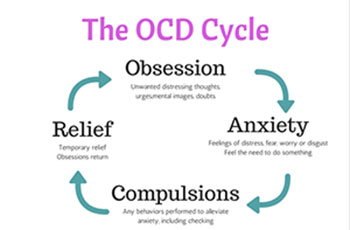
Obsessive Compulsive Disorder
Obsessive-Compulsive Disorder (OCD) is a common and long-lasting disorder in which a person has uncontrollable, reoccurring thoughts (obsessions) and behaviors (compulsions) that he or she feels the urge to repeat over and over.
Signs and Symptoms
People with OCD may have symptoms of obsessions, compulsions, or both. These symptoms can interfere with all aspects of life, such as work, school, and personal relationships.

Obsessions are repeated thoughts, urges, or mental images that cause anxiety. Common symptoms include:
-
Fear of germs or contamination
-
Unwanted forbidden or taboo thoughts involving sex, religion, and harm
-
Aggressive thoughts towards others or self
-
Having things symmetrical or in a perfect order
Compulsions are repetitive behaviors that a person with OCD feels the urge to do in response to an obsessive thought. Common compulsions include:
-
Excessive cleaning and/or handwashing
-
Ordering and arranging things in a particular, precise way
-
Repeatedly checking on things, such as repeatedly checking to see if the door is locked or that the oven is off
-
Compulsive counting
How is OCD different from normal behaviors?
Not all rituals or habits are compulsions. Everyone double checks things sometimes. We all check our doors at night and double-check things for our safety. But a person with OCD generally:
-
Can't control his or her thoughts or behaviors, even when those thoughts or behaviors are recognized as excessive
-
Spends at least 1 hour a day on these thoughts or behaviors
-
Doesn’t get pleasure when performing the behaviors or rituals, but may feel brief relief from the anxiety the thoughts cause
-
Experiences significant problems in their daily life due to these thoughts or behaviors
Some individuals with OCD also have a tic disorder. Motor tics are sudden, brief, repetitive movements, such as eye blinking and other eye movements, facial grimacing, shoulder shrugging, and head or shoulder jerking. Common vocal tics include repetitive throat-clearing, sniffing, or grunting sounds.
Diagnosis:
Symptoms may come and go, ease over time, or worsen. People with OCD may try to help themselves by avoiding situations that trigger their obsessions. Although most adults with OCD recognize that what they are doing doesn’t make sense, some adults and most children may not realize that their behavior is out of the ordinary. About 2% of children suffer from OCD. The cause is unknown There appear to be some genetic components with both identical twins more often affected than both non-identical twins. Risk factors include a history of child abuse or other stress-inducing event. Some cases have been documented to occur following infections. The diagnosis is based on the symptoms and requires ruling out other drug related or medical causes. Other disorders with similar symptoms include anxiety disorder, major depressive disorder, eating disorders, tic disorders, and obsessive–compulsive personality disorder.
Treatment
Treatment involves counseling, such as cognitive behavioral therapy (CBT), and sometimes antidepressants such as selective serotonin reuptake inhibitors (SSRIs) or clomipramine The specific technique used in CBT is called exposure and response prevention (ERP) which involves teaching the person to deliberately come into contact with the situations that trigger the obsessive thoughts and fears ("exposure"), without carrying out the usual compulsive acts associated with the obsession ("response prevention"). Thus the patient gradually learns to tolerate the discomfort and anxiety associated with not performing the ritualistic behavior. With proper treatment the patient can lead resume normal to near - normal life.